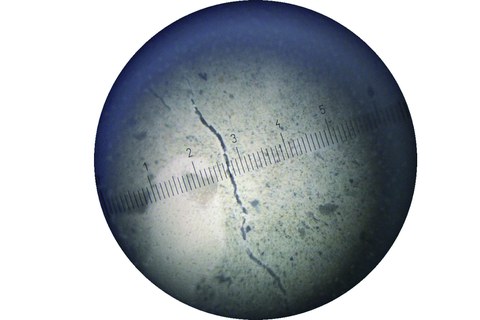Enhancement of the prediction accuracy of small crack width
Table of contents
Project data
| Titel | Title Verbesserung der Vorhersagequalität von sehr kleinen Rissbreiten | Enhancement of the prediction accuracy of small crack width Förderer | Funding Deutsches Institut für Bautechnik (DIBt), ZP 52-5-7.275-1245/07 Zeitraum | Period 01.2007 – 02.2009 Leiter | Project Manager Prof. Dr.-Ing. Dr.-Ing. E.h. Manfred Curbach Bearbeiter | Contributor Dr.-Ing. Lars Eckfeldt |
Report in the yearbook 2009
Small Crack Width Prediction

Small crack through a crack measuring magnifier
In order to be in compliance with the German Association for Reinforced Concrete (DAfStb) guideline, entitled „Use of Concrete Subjected to Substances Hazardous to Water“ (BUmwS), the effective crack width of reinforced concrete (RC) members employed in water-tight containers or facilities used for storing, filling, transporting, and shipping water must be limited to 0.1 mm. Only crack widths falling between 0.2 mm to 0.4 mm are detailed under the German code
DIN 1045-1.
A study of literature test data indicated that uncertainty increased dramatically for crack width predictions when characteristic crack width wk is below 0.2 mm as compared to regular, larger crack widths. It is estimated that in 70 % of all attempts to determine characteristic a crack width of
wk ≤ 0.1 mm in accordance with DIN 1045-1 the mean crack widths within the structure would exceed this limit. This would require large amounts of repair work as a rule. Other models checked for a characteristic crack width of wk ≤ 0.1 mm also indicated a 65 % probability of exceeding this minimum limit.
Recent Test Results
Tests were performed on 600 mm and 3000 mm reinforced tensile specimens to research the randomness of cracking relative to bond performance. These tests focused attention on primary cracking; crack sequencing and position; crack stresses; deformation development; crack widths; and relevant statistical distributions. This research resulted in the development of models to insure crack control in primary cracking, as well as more reliable alternatives for calculating crack widths in stabilized cracking. Results were nearly congruent to current German standards and can be used as a starting point for future projects.
The statistically confirmed models discussed possess an increased probability of not exceeding predicted crack widths for the price of a substantially higher quantity of reinforcement. The research report published contains additional measurement readings and analysis of the shape of inner crack faces. Human error in taking readings of crack widths using a microscope or magnifying glass, as well as local stress-strain readings on long bond lengths surrounding cracks trough the entire element are also discussed. Photographs of the shape and spread of internal micro-cracks located within the bond zone between steel and concrete and test evidence of random strength fields are also included in these results.
Published
Comprehensive Research Report:
Eckfeldt et. al.: Verbesserung der Vorhersagequalität von sehr kleinen Rissbreiten. Abschlussbericht, TU Dresden, 2009, 316 pages
Short Report:
DIBt: Verbesserung der Vorhersagequalität von Rissbreiten. DIBt-Mitteilungen, 5/2009,
p. 159-164, 6/2009 p. 221
